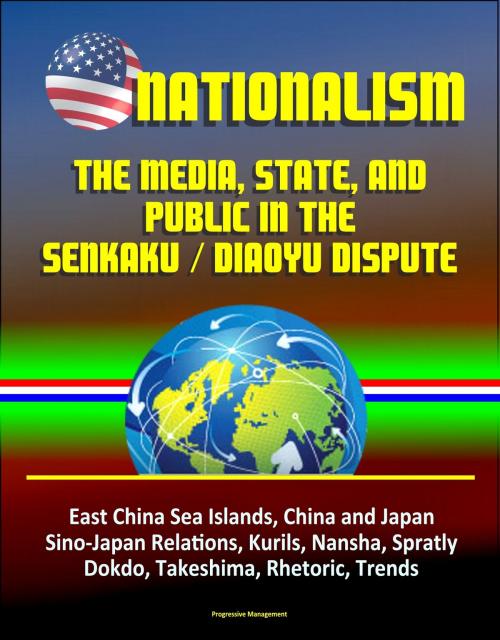Nationalism: The Media, State, and Public in the Senkaku / Diaoyu Dispute - East China Sea Islands, China and Japan, Sino-Japan Relations, Kurils, Nansha, Spratly, Dokdo, Takeshima, Rhetoric, Trends
Nonfiction, History, Asian, Japan, China| Author: | Progressive Management | ISBN: | 9781310394539 |
| Publisher: | Progressive Management | Publication: | March 27, 2016 |
| Imprint: | Smashwords Edition | Language: | English |
| Author: | Progressive Management |
| ISBN: | 9781310394539 |
| Publisher: | Progressive Management |
| Publication: | March 27, 2016 |
| Imprint: | Smashwords Edition |
| Language: | English |
Professionally converted for accurate flowing-text e-book format reproduction, this unique study considers the extent to which China and Japan are instrumentally influencing nationalist rhetoric in the media in order to advance state interests. Since diplomatic normalization in 1972, Sino-Japan relations have hit a new low due to escalating military and diplomatic confrontation around the islands in the East China Sea, known as the Senkaku in Japan and the Diaoyu in China.
Media analysis indicates a pattern of rising nationalist rhetoric in both Japan and China over the 23-year period from 1990 to 2013. Contextual analysis of historical events also suggests that both China and Japan have used the dispute instrumentally to bolster domestic support while attempting to manage nationalist rhetoric in order to prevent negative international consequences. However, due to popular nationalism transforming journalistic and political consensus, Tokyo's influence over the media in Japan declined steeply after 2010. In China, the state maintains strict oversight over the media and public mobilizations, but Beijing may also be slowly losing its control over popular nationalism. In sum, popular nationalism may be growing beyond state control, limiting political options to improve bilateral relations for both Chinese and Japanese leaders.
CHAPTER I * INTRODUCTION * A. MAJOR RESEARCH QUESTION * B. SIGNIFICANCE OF THE RESEARCH QUESTION * C. ORIGINS OF CHINESE AND JAPANESE NATIONALISM * 1. Chinese Nationalism * 2. Japanese Nationalism * D. THE SENKAKU/DIAOYU ISLANDS * E. POTENTIAL EXPLANATIONS AND HYPOTHESES * CHAPTER II * THE MEDIA, PUBLIC, AND STATE * A. THE MEDIA, PUBLIC, AND STATE: THE MEDIA IN A LIBERAL DEMOCRACY * B. THE COMPROMISED MEDIA IN CHINA * C. THE COMPROMISED MEDIA IN JAPAN * D. THE MEDIA FREEDOM INDICES * E. CONCLUSION: THE RELATIONSHIPS BETWEEN THE MEDIA, PUBLIC, AND STATE IN CHINA AND JAPAN . * CHAPTER III * RESEARCH SOURCES AND DESIGN * A. RESEARCH FRAMEWORK: CRITICAL DISCOURSE ANALYSIS * B. AUTONOMOUS AGENDA-SETTING BY THE MEDIA * C. RESEARCH SOURCES * D. RESEARCH METHODS * CHAPTER IV * QUANTITATIVE TRENDS IN THE DISPUTE * A. BACKGROUND ON OTHER TERRITORIAL DISPUTES * 1. The Dokdo/Takeshima Islands Dispute * 2. The Kuril Islands/Northern Territories Dispute * 3. The Nansha/Spratly Islands Dispute * 4. Sino-Indian Border Dispute * B. QUANTITATIVE TRENDS IN COVERAGE * 1. Tables, Figures, and Methods * 2. Comparative Quantitative Trends in the Japanese Coverage * 3. Comparative Quantitative Trends in the Chinese Coverage * 4. Summary * C. POLLING DATA * 1. Tables and Methods * 2. Comparative Trends in Polling Data: the Japanese Attitude toward China and South Korea * 3. Comparative Trends in Polling Data: the Chinese Attitude toward Japan and India * 4. Summary * D. THE USAGE OF NAMES AND TERMS IN THE DISPUTE * 1. Tables, Graphs, and Methods * 2. Trends in Usage of National Names for the SDI Dispute * 3. Summary * E. OVERALL TRENDS * CHAPTER V * QUALITATIVE TRENDS IN THE DISPUTE * A. TABLES AND METHODS * B. CRITERIA FOR DETERMINING THE EXTENT OF STATE INFLUENCE IN THE MEDIA * C. QUALITATIVE TRENDS IN JAPANESE MEDIA * 1. 1992: The Japanese Emperor's Visit to China * a. 1992 - Major Events * b. 1992 - Analysis * c. 1992 - Summary * 2. 1996: Construction of a Lighthouse by a Right-Wing Organization * a. 1996 - Major Events * b. 1996 - Analysis * c. 1996 - Summary * 3. 2004: Japan Arrests/Detains Chinese Activists who Land on the Islands * a. 2004 - Major Events * b. 2004 - Analysis * c. 2004 - Summary * 4. 2010: Trawler Incident and the Video Leak - The Year of Change * a. 2010 - Major Events
Professionally converted for accurate flowing-text e-book format reproduction, this unique study considers the extent to which China and Japan are instrumentally influencing nationalist rhetoric in the media in order to advance state interests. Since diplomatic normalization in 1972, Sino-Japan relations have hit a new low due to escalating military and diplomatic confrontation around the islands in the East China Sea, known as the Senkaku in Japan and the Diaoyu in China.
Media analysis indicates a pattern of rising nationalist rhetoric in both Japan and China over the 23-year period from 1990 to 2013. Contextual analysis of historical events also suggests that both China and Japan have used the dispute instrumentally to bolster domestic support while attempting to manage nationalist rhetoric in order to prevent negative international consequences. However, due to popular nationalism transforming journalistic and political consensus, Tokyo's influence over the media in Japan declined steeply after 2010. In China, the state maintains strict oversight over the media and public mobilizations, but Beijing may also be slowly losing its control over popular nationalism. In sum, popular nationalism may be growing beyond state control, limiting political options to improve bilateral relations for both Chinese and Japanese leaders.
CHAPTER I * INTRODUCTION * A. MAJOR RESEARCH QUESTION * B. SIGNIFICANCE OF THE RESEARCH QUESTION * C. ORIGINS OF CHINESE AND JAPANESE NATIONALISM * 1. Chinese Nationalism * 2. Japanese Nationalism * D. THE SENKAKU/DIAOYU ISLANDS * E. POTENTIAL EXPLANATIONS AND HYPOTHESES * CHAPTER II * THE MEDIA, PUBLIC, AND STATE * A. THE MEDIA, PUBLIC, AND STATE: THE MEDIA IN A LIBERAL DEMOCRACY * B. THE COMPROMISED MEDIA IN CHINA * C. THE COMPROMISED MEDIA IN JAPAN * D. THE MEDIA FREEDOM INDICES * E. CONCLUSION: THE RELATIONSHIPS BETWEEN THE MEDIA, PUBLIC, AND STATE IN CHINA AND JAPAN . * CHAPTER III * RESEARCH SOURCES AND DESIGN * A. RESEARCH FRAMEWORK: CRITICAL DISCOURSE ANALYSIS * B. AUTONOMOUS AGENDA-SETTING BY THE MEDIA * C. RESEARCH SOURCES * D. RESEARCH METHODS * CHAPTER IV * QUANTITATIVE TRENDS IN THE DISPUTE * A. BACKGROUND ON OTHER TERRITORIAL DISPUTES * 1. The Dokdo/Takeshima Islands Dispute * 2. The Kuril Islands/Northern Territories Dispute * 3. The Nansha/Spratly Islands Dispute * 4. Sino-Indian Border Dispute * B. QUANTITATIVE TRENDS IN COVERAGE * 1. Tables, Figures, and Methods * 2. Comparative Quantitative Trends in the Japanese Coverage * 3. Comparative Quantitative Trends in the Chinese Coverage * 4. Summary * C. POLLING DATA * 1. Tables and Methods * 2. Comparative Trends in Polling Data: the Japanese Attitude toward China and South Korea * 3. Comparative Trends in Polling Data: the Chinese Attitude toward Japan and India * 4. Summary * D. THE USAGE OF NAMES AND TERMS IN THE DISPUTE * 1. Tables, Graphs, and Methods * 2. Trends in Usage of National Names for the SDI Dispute * 3. Summary * E. OVERALL TRENDS * CHAPTER V * QUALITATIVE TRENDS IN THE DISPUTE * A. TABLES AND METHODS * B. CRITERIA FOR DETERMINING THE EXTENT OF STATE INFLUENCE IN THE MEDIA * C. QUALITATIVE TRENDS IN JAPANESE MEDIA * 1. 1992: The Japanese Emperor's Visit to China * a. 1992 - Major Events * b. 1992 - Analysis * c. 1992 - Summary * 2. 1996: Construction of a Lighthouse by a Right-Wing Organization * a. 1996 - Major Events * b. 1996 - Analysis * c. 1996 - Summary * 3. 2004: Japan Arrests/Detains Chinese Activists who Land on the Islands * a. 2004 - Major Events * b. 2004 - Analysis * c. 2004 - Summary * 4. 2010: Trawler Incident and the Video Leak - The Year of Change * a. 2010 - Major Events















